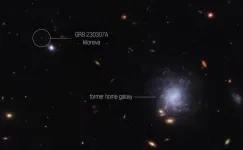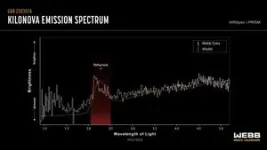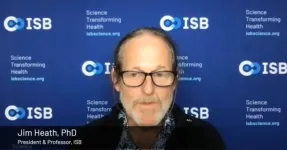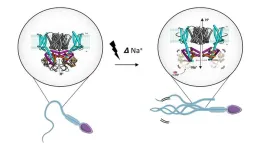(Press-News.org) A team of scientists has used multiple space and ground-based telescopes, including NASA’s James Webb Space Telescope, NASA’s Fermi Gamma-ray Space Telescope, and NASA’s Neil Gehrels Swift Observatory, to observe an exceptionally bright gamma-ray burst, GRB 230307A, and identify the neutron star merger that generated an explosion that created the burst. Webb also helped scientists detect the chemical element tellurium in the explosion’s aftermath.
Other elements near tellurium on the periodic table – like iodine, which is needed for much of life on Earth – are also likely to be present among the kilonova’s ejected material. A kilonova is an explosion produced by a neutron star merging with either a black hole or with another neutron star.
“Just over 150 years since Dmitri Mendeleev wrote down the periodic table of elements, we are now finally in the position to start filling in those last blanks of understanding where everything was made, thanks to Webb,” said Andrew Levan of Radboud University in the Netherlands and the University of Warwick in the UK, lead author of the study.
While neutron star mergers have long been theorized as being the ideal “pressure cookers” to create some of the rarer elements substantially heavier than iron, astronomers have previously encountered a few obstacles in obtaining solid evidence.
Long Gamma-Ray Burst
Kilonovae are extremely rare, making it difficult to observe these events. Short gamma-ray bursts (GRBs), traditionally thought to be those that last less than two seconds, can be byproducts of these infrequent merger episodes. (In contrast, long gamma-ray bursts may last several minutes and are usually associated with the explosive death of a massive star.)
The case of GRB 230307A is particularly remarkable. First detected by Fermi in March, it is the second brightest GRB observed in over 50 years of observations, about 1,000 times brighter than a typical gamma-ray burst that Fermi observes. It also lasted for 200 seconds, placing it firmly in the category of long duration gamma-ray bursts, despite its different origin.
“This burst is way into the long category. It’s not near the border. But it seems to be coming from a merging neutron star,” added Eric Burns, a co-author of the paper and member of the Fermi team at Louisiana State University.
Opportunity: Telescope Collaboration
The collaboration of many telescopes on the ground and in space allowed scientists to piece together a wealth of information about this event as soon as the burst was first detected. It is an example of how satellites and telescopes work together to witness changes in the universe as they unfold.
After the first detection, an intensive series of observations from the ground and from space, including with Swift, swung into action to pinpoint the source on the sky and track how its brightness changed. These observations in the gamma-ray, X-ray, optical, infrared, and radio showed that the optical/infrared counterpart was faint, evolved quickly, and became very red – the hallmarks of a kilonova.
“This type of explosion is very rapid, with the material in the explosion also expanding swiftly,” said Om Sharan Salafia, a co-author of the study at the INAF – Brera Astronomical Observatory in Italy. “As the whole cloud expands, the material cools off quickly and the peak of its light becomes visible in infrared, and becomes redder on timescales of days to weeks.”
At later times it would have been impossible to study this kilonova from the ground, but these were the perfect conditions for Webb’s NIRCam (Near-Infrared Camera) and NIRSpec (Near-Infrared Spectrograph) instruments to observe this tumultuous environment. The spectrum has broad lines that show the material is ejected at high speeds, but one feature is clear: light emitted by tellurium, an element rarer than platinum on Earth.
The highly sensitive infrared capabilities of Webb helped scientists identify the home address of the two neutron stars that created the kilonova: a spiral galaxy about 120,000 light-years away from the site of the merger.
Prior to their venture, they were once two normal massive stars that formed a binary system in their home spiral galaxy. Since the duo was gravitationally bound, both stars were launched together on two separate occasions: when one among the pair exploded as a supernova and became a neutron star, and when the other star followed suit.
In this case, the neutron stars remained as a binary system despite two explosive jolts and were kicked out of their home galaxy. The pair traveled approximately the equivalent of the Milky Way galaxy’s diameter before merging several hundred million years later.
Scientists expect to find even more kilonovae in the future due to the increasing opportunities to have space and ground-based telescopes work in complementary ways to study changes in the universe. For example, while Webb can peer deeper into space than ever before, the remarkable field of view of NASA’s upcoming Nancy Grace Roman Space Telescope will enable astronomers to scout where and how frequently these explosions occur.
“Webb provides a phenomenal boost and may find even heavier elements,” said Ben Gompertz, a co-author of the study at the University of Birmingham in the UK. “As we get more frequent observations, the models will improve and the spectrum may evolve more in time. Webb has certainly opened the door to do a lot more, and its abilities will be completely transformative for our understanding of the universe.”
These findings have been published in the journal Nature.
The James Webb Space Telescope is the world’s premier space science observatory. Webb is solving mysteries in our solar system, looking beyond to distant worlds around other stars, and probing the mysterious structures and origins of our universe and our place in it. Webb is an international program led by NASA with its partners, ESA (European Space Agency) and the Canadian Space Agency.
END
NASA's Webb makes first detection of heavy element from star merger
2023-10-25
ELSE PRESS RELEASES FROM THIS DATE:
A bold plan to 3D print artificial coral reef
2023-10-25
Inspired by the remarkable durability of ancient Roman construction materials in seawater, a University of Texas at Arlington civil engineering researcher is attempting to duplicate Roman concrete by developing 3D-printed materials to restore damaged or dying coral reefs.
Warda Ashraf, associate professor in the Department of Civil Engineering, will lead a multidisciplinary team, funded by a $2 million National Science Foundation (NSF) grant, that aims to build 3D-printed artificial reefs. The team’s project is titled “Carbon Sequestration and Coastal Resilience Through 3D Printed Reefs” ...
ESnet turns on 400G circuits to four DOE national labs, supercharging multi-site scientific research
2023-10-25
– By Bonnie Powell
Today’s world-changing scientific research is being conducted by collaborators at far-flung national laboratories who require high-speed, low-latency access to high performance computing facilities and specialized instruments. The Energy Sciences Network (ESnet) is proud to announce that it has supercharged the current and future bandwidth for four of the Department of Energy’s (DOE’s) national laboratories and user facilities, unleashing 400 Gigabit per second (400G) capability for Argonne National Laboratory, ...
MD Anderson Research Highlights for October 25, 2023
2023-10-25
HOUSTON ― The University of Texas MD Anderson Cancer Center’s Research Highlights showcases the latest breakthroughs in cancer care, research and prevention. These advances are made possible through seamless collaboration between MD Anderson’s world-leading clinicians and scientists, bringing discoveries from the lab to the clinic and back.
Recent developments at MD Anderson include positive results from a Phase I trial for patients with TP53-mutant acute myeloid leukemia, a novel machine learning ...
Can AI grasp related concepts after learning only one?
2023-10-25
Humans have the ability to learn a new concept and then immediately use it to understand related uses of that concept—once children know how to “skip,” they understand what it means to “skip twice around the room” or “skip with your hands up.”
But are machines capable of this type of thinking? In the late 1980s, Jerry Fodor and Zenon Pylyshyn, philosophers and cognitive scientists, posited that artificial neural networks—the engines that drive artificial intelligence and machine learning— are not capable of making these connections, known as “compositional generalizations.” However, in the decades ...
Breakthrough T cell discovery has huge potential for engineering custom immune responses
2023-10-25
SEATTLE – T cells are soldiers on the front lines of the human immune system. They are responsible for many important roles, including attacking viral- or bacterial-infected cells and certain cancer cells, and immunological memory – remembering the specific pathogens or the cancer signatures that originally trigger T cells.
Until now, understanding how a T cell forms into a specific role, for example a cell-killing (cytotoxic) T cell or memory T cell, has eluded us. In a paper that will be published online by Cell Reports on October 25, ISB researchers made the breakthrough ...
Sperm's secret voltage switch: Scientists unlock the mystery of motility
2023-10-25
Researchers at Stockholm University have unveiled the hidden intricacies of how sperm go from passive bystanders to dynamic swimmers. This transformation is a pivotal step in the journey to fertilization, and it hinges on the activation of a unique ion transporter.
Imagine sperm as tiny adventurers on a quest to reach the ultimate treasure, the egg. They don't have a map, but they make use of something even more extraordinary: chemo-attractants. These are chemical signals released by the egg that act as siren call, directing and activating the sperm. When these signals bind to receptors on the sperm's surface, it triggers a series of events, starting their movement towards ...
Simple blood test can help diagnose bipolar disorder
2023-10-25
Researchers have developed a new way of improving diagnosis of bipolar disorder that uses a simple blood test to identify biomarkers associated with the condition.
The researchers, from the University of Cambridge, used a combination of an online psychiatric assessment and a blood test to diagnose patients with bipolar disorder, many of whom had been misdiagnosed with major depressive disorder.
The researchers say the blood test on its own could diagnose up to 30% of patients with bipolar disorder, but that it is even more effective when combined with a digital mental health assessment.
Incorporating biomarker ...
New study identifies illegal hunting as a threat to China’s wildlife and global public health
2023-10-25
Illegal hunting and trading of wildlife in China is becoming a significant threat to biodiversity and public health, according to a new paper by a team of researchers that includes two scholars from the School of Public and International Affairs. It is the first comprehensive assessment of this issue for China.
The paper, "Assessing the illegal hunting of native wildlife in China," appears in Nature today. Its co-authors are Dan Liang, Xingli Giam, Sifan Hu, Liang Ma, and David S. Wilcove. Liang is an associate research scholar at SPIA's Center for Policy Research on Energy and the ...
Age, body mass index, tumor subtype, and racial and ethnic disparities in breast cancer survival
2023-10-25
About The Study: In this study with 9,479 participants, racial and ethnic survival disparities were identified in patients with early-stage breast cancer receiving standardized initial care, and potentially at-risk subgroups, for whom focused interventions may improve outcomes, were found.
Authors: Erica T. Warner, Sc.D., of Massachusetts General Hospital in Boston, is the corresponding author.
To access the embargoed study: Visit our For The Media website at this link https://media.jamanetwork.com/
(doi:10.1001/jamanetworkopen.2023.39584
Editor’s Note: Please see the article for additional ...
Metformin cessation and dementia incidence
2023-10-25
About The Study: Terminating metformin treatment was associated with increased dementia incidence in this study of 12,000 early terminators and 29,000 routine users of metformin. This finding may have important implications for clinical treatment of adults with diabetes and provides additional evidence that metformin is associated with reduced dementia risk.
Authors: Sarah F. Ackley, Ph.D., of Boston University, Boston, is the corresponding author.
To access the embargoed study: Visit our For The Media website at this link https://media.jamanetwork.com/
(doi:10.1001/jamanetworkopen.2023.39723)
Editor’s Note: Please see the article ...





